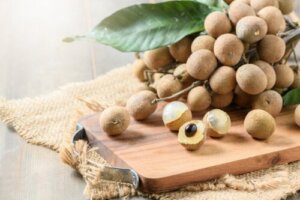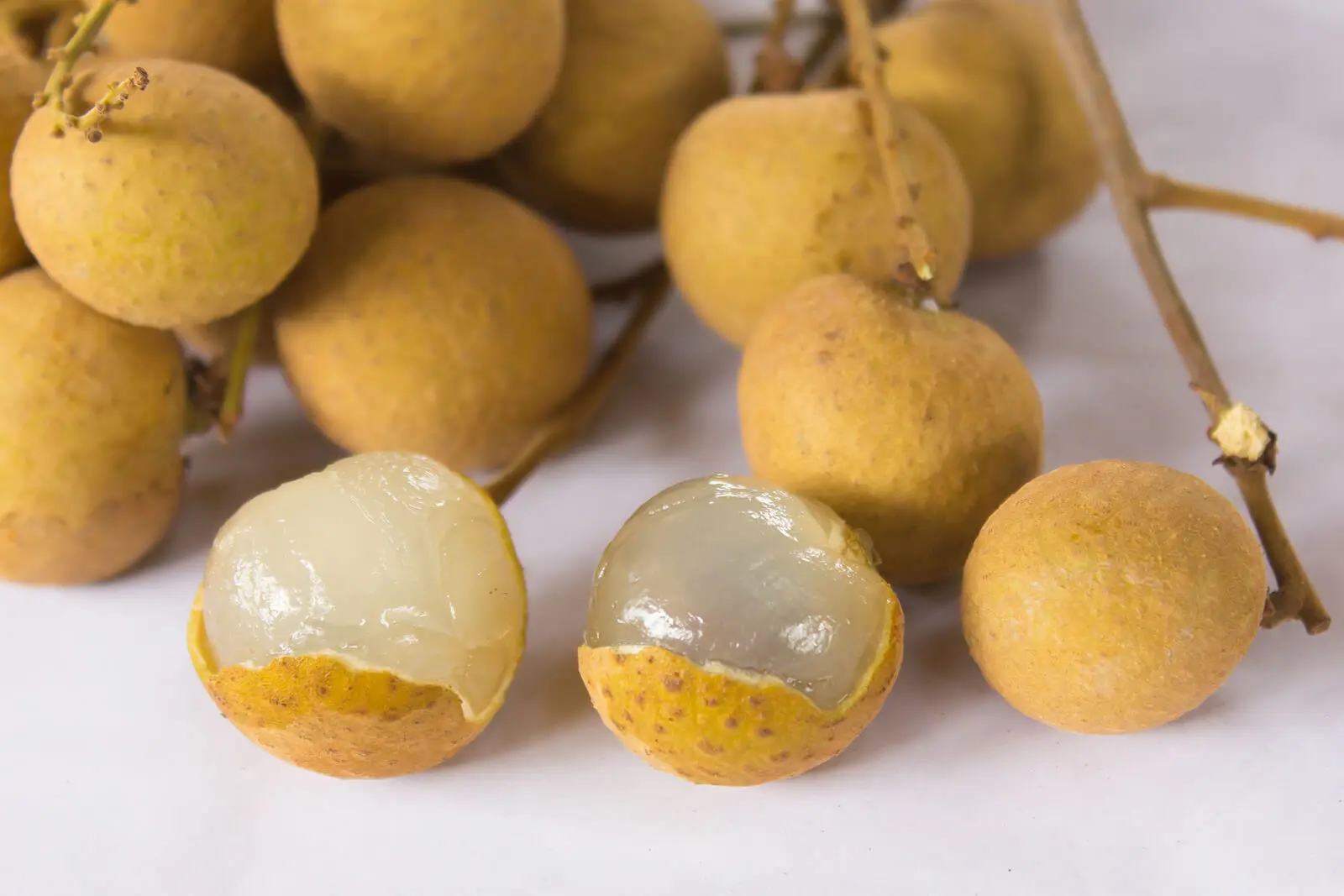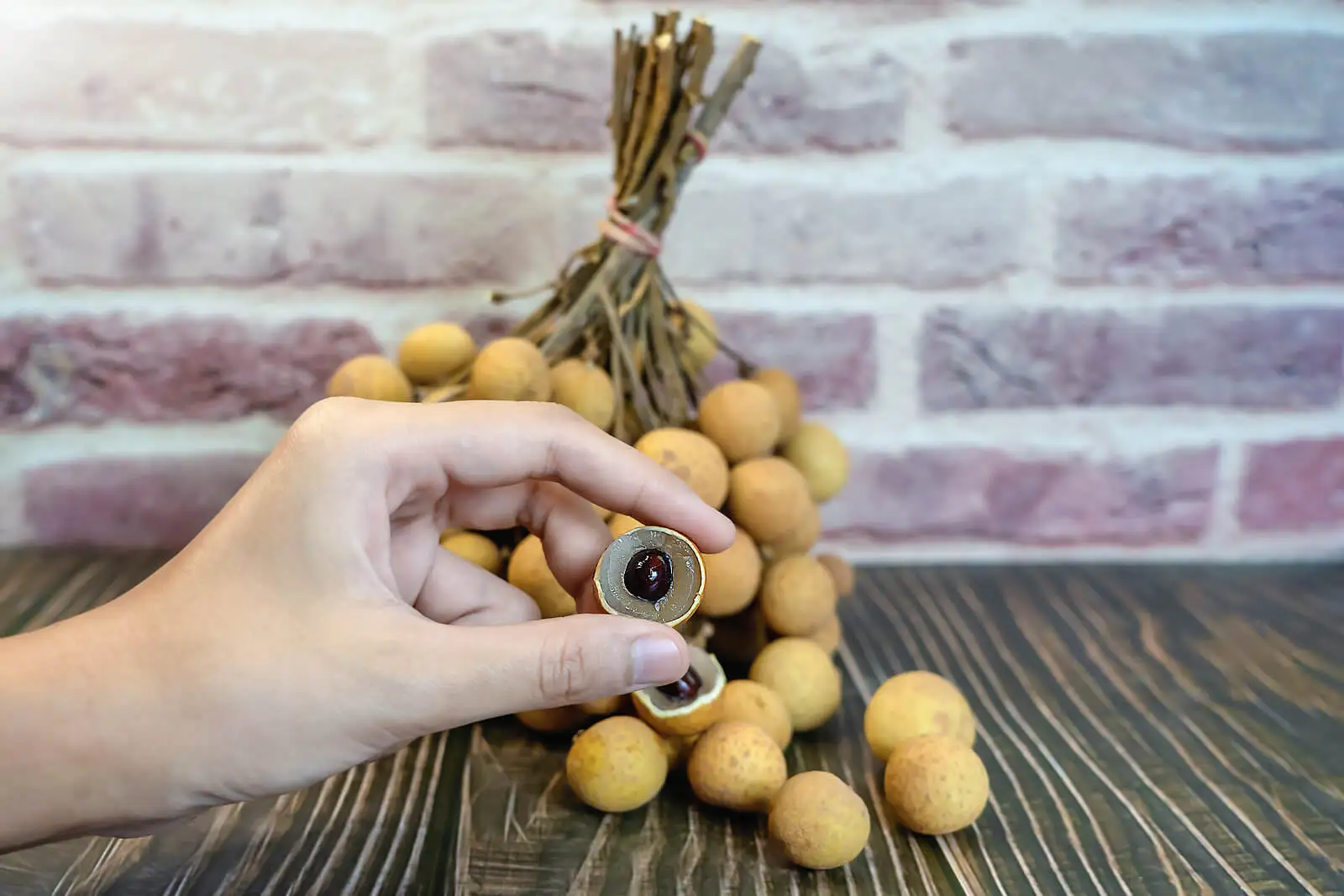The Longan or Dragon's Eye: How Nutritious Is this Exotic Fruit?


Written and verified by the nutritionist Maria Patricia Pinero Corredor
The longan is a small tropical fruit, whose black seed and white pulp resembles an eyeball, and that’s why it’s also known as “dragon’s eye fruit”. It’s native to China and has become popular in the markets of Thailand, Indonesia, India, and Vietnam.
In fact, it has also spread to other regions of the world. It’s related to lychees, but its texture and flavor is different. It’s used in sorbets, smoothies, puddings, and salads. Due to its antioxidant properties, it’s considered a very special fruit. In Asian medicine, it’s used for its bioactive compounds.
In particular, its consumption is associated with the prevention of flu, colds, and other illnesses. What’s its nutritional value? What are its benefits? To learn more about this exotic fruit, we invite you to continue reading.
What is longan or dragon’s eye?
The longan (Dimocarpus longan L.), also called “dragon’s eye”, is a subtropical fruit of the Sapindaceae family and is the second most important crop in production after its relative, the lychee.
It’s described as a juicy fruit with a white, fleshy, translucent fruit surrounding a brown to black seed. Its shell is brown to yellowish in color and grows in hanging clusters. Each fruit is the size of a large olive; it’s sometimes called a “berry,” although it has no berry characteristics.
They’re usually consumed fresh, but are also sold frozen, canned, or dried. The fresh pulp resembles that of a grape in flavor and texture, although it has a hint of musk. When dried, they adopt a smoky flavor that’s used to prepare a refreshing drink in India.
Curiously, the seed is used in shampoo due to its high content of saponins. In traditional medicine, it also has several applications. For example, it’s used as an adjuvant against insomnia, amnesia, fungus, among others.

Main nutrients of the longan
The nutritional composition of 100 grams (4 oz) of longan pulp is as follows:
- Calories: 60 kcal.
- Moisture: 72 to 83 grams.
- Protein: 1.0 to 1.3 grams.
- Carbohydrates: 15 to 25 grams.
- Fiber: 0.4 to 1.1 gram.
- Vitamin A: 28 international units.
- Vitamin C: 60 to 84 milligrams (140 % of DV).
- Potassium: 266 milligrams (8 % of DV).
- Copper: 0.17 milligrams (3 % of the DV).
The most prominent nutrient in the longan is vitamin C, whose values cover more than 40% of our daily requirements. The ascorbic acid content is double that of citrus fruits such as oranges, lemons, tangerines, among others.
Of course, the value of this vitamin predominates in fresh fruit, since heat destroys it. An important characteristic of ascorbic acid is its antioxidant capacity.
The longan also provides a good percentage of carbohydrates, mostly represented by simple sugars, such as sucrose, fructose, and glucose. These sugars are highly absorbed and digestible.
Bioactive compounds of the longan
In addition to these nutrients, longan is notable for containing certain active substances that play a major role in health. This fruit contains significant amounts of polyphenols with antioxidant capacity, such as corilagin, ellagic acid, quercetin, and kaempferol, among others.
These compounds have the ability to eliminate free radicals, inhibit oxidation and prevent certain diseases. It has also been found that most of them are concentrated in the seed, which has 2 to 5 times more compared to the peel.
Read more: 8 Symptoms of a Vitamin C Deficiency
Possible benefits of the longan
The nutrients and bioactive compounds present in the longan have important benefits related to antioxidant and anti-inflammatory properties. They are said to help in disease prevention.
It is a source of vitamin C
Vitamin C is a potent antioxidant that strengthens the immune system, skin, and eye health. Molecules magazine points out that consuming longans reduces oxidative damage to the skin, as it provides high values of vitamin C. It eliminates flaking and minimizes cracking, preserving cell integrity.
Antioxidant and anti-inflammatory capacity
A group of researchers reported that polyphenols present in the longan fight inflammation, infection, and oxidative stress. Polyphenols are known to protect against heart disease, diabetes, liver disorders, and possibly prevent cancer.
Another group of experts showed that this fruit has anti-inflammatory properties and increases antioxidant enzymes. In addition, it can strengthen the immune system, prevent osteoporosis, and have anti-aging effects.
It acts as an antibacterial, antifungal, and antiviral
Some scientists claim that the bioactive compounds in longan juice can improve intestinal health. It also boosts the immune system. It was observed that this drink can protect against inflammatory responses, flu, colds, and skin conditions.
Improves sleep quality
A study found that longan improves sleep quality and duration. The extract of this fruit may decrease anxiety and stress by lowering levels of the hormone known as cortisol.
May improve memory
Research in mice determined that consuming longan may benefit brain structure and thus help process memories. Because of this, the results were applied to patients with neurodegenerative diseases such as Alzheimer’s.
In Chinese medicine, it’s part of the treatment to improve anxiety levels, cognitive function and memory.
How to prepare longan?
Longan is most often consumed as a fresh fruit. The pulp is the only edible part. It’s also prepared as dried pulp, juice, jelly, wine, and canned in syrup. It can also be added to a fruit salad along with citrus and mint. It can even be used in the following:
- Cheesecakes
- Cookies
- Cocktails
- Smoothies
- Jellies
- Jams
You can make a delicious smoothie blending longan with coconut milk and banana. It can also be added to oatmeal and then cooked. Meanwhile, it should be noted that infusions with dried longan and red dates are part of traditional Asian culture.

The longan, a nutritious fruit
The longan is an exotic fruit that provides low calories. It’s mainly composed of carbohydrates, as its fats and proteins are very low. The types of carbohydrates that predominate are sugars that are absorbed quickly.
Its most appreciated nutrient is vitamin C, so to get the most out of it, it’s recommended to eat it fresh or in the form of freshly prepared juice. This nutrient has a dual function, as it nourishes and acts as an antioxidant.
Among other things, it provides many polyphenols with antioxidant and anti-inflammatory properties. For this reason, this fruit is considered very beneficial.
All cited sources were thoroughly reviewed by our team to ensure their quality, reliability, currency, and validity. The bibliography of this article was considered reliable and of academic or scientific accuracy.
- Huang GJ, Wang BS, Lin WC, Huang SS, Lee CY, Yen MT, Huang MH. Antioxidant and Anti-Inflammatory Properties of Longan (Dimocarpus longan Lour.) Pericarp. Evid Based Complement Alternat Med. 2012;2012:709483. doi: 10.1155/2012/709483. Epub 2012 Aug 26. PMID: 22966244; PMCID: PMC3433710.
- Marisa M. Wall, Ascorbic acid and mineral composition of longan (Dimocarpus longan), lychee (Litchi chinensis) and rambutan (Nephelium lappaceum) cultivars grown in Hawaii, Journal of Food Composition and Analysis, Volume 19, Issues 6–7, 2006, Pages 655-663, ISSN 0889-1575, https://doi.org/10.1016/j.jfca.2005.12.001. (https://www.sciencedirect.com/science/article/pii/S0889157505001304)
- Mishra, D.s & Chakraborty, Binayak & Rymbai, Heiplanmi & Deshmukh, Nishant & Jha, Anjani Kumar & War, G & Paul, Debanjoy & Patel, R & Mishra, L & Roy, D & Lyngdoh, Pynkhrawbor. (2018). LONGAN (Dimocarpus longan Lour). Disponible en: https://www.researchgate.net/publication/328043052_LONGAN_Dimocarpus_longan_Lour/citation/download
- Tang Y., Cai W., Xu B. From rice bag to table: Fate of phenolic chemical compositions and antioxidant activities in waxy and non-waxy black rice during home cooking. Food Chem. 2016;191:81–90. doi: 10.1016/j.foodchem.2015.02.001.
- Pullar, J. M., Carr, A. C., & Vissers, M. (2017). The Roles of Vitamin C in Skin Health. Nutrients, 9(8), 866. https://doi.org/10.3390/nu9080866
- Instituto Nacional de Salud. Ministerio de Salud. Perú. Consumo de vitamina C fortalece el sistema inmunológico ante amenaza de enfermedades infecciosas. Disponible en: https://web.ins.gob.pe/es/prensa/noticia/consumo-de-vitamina-c-fortalece-el-sistema-inmunologico-ante-amenaza-de-enfermedades
- Bao Yang, Yueming Jiang, John Shi, Feng Chen, Muhammad Ashraf, Extraction and pharmacological properties of bioactive compounds from longan (Dimocarpus longan Lour.) fruit — A review, Food Research International, Volume 44, Issue 7, 2011, Pages 1837-1842,
- ISSN 0963-9969, https://doi.org/10.1016/j.foodres.2010.10.019. (https://www.sciencedirect.com/science/article/pii/S0963996910003820)
- Nuchanart Rangkadilok, Somkid Sitthimonchai, Luksamee Worasuttayangkurn, Chulabhorn Mahidol, Mathuros Ruchirawat, Jutamaad Satayavivad. Evaluation of free radical scavenging and antityrosinase activities of standardized longan fruit extract. Food Chem Toxicol. 2007 Feb;45(2):328-36. doi: 10.1016/j.fct.2006.08.022. Epub 2006 Sep 12.
- Shi, Y., Dong, J. W., Zhao, J. H., Tang, L. N., & Zhang, J. J. (2014). Herbal Insomnia Medications that Target GABAergic Systems: A Review of the Psychopharmacological Evidence. Current neuropharmacology, 12(3), 289–302. https://doi.org/10.2174/1570159X11666131227001243
- Se Jin Park, Dong Hyun Park , Dong Hyun Kim , Seungjoo Lee , Byung Hoon Yoon , Won Yong Jung , Kyung Tae Lee , Jae Hoon Cheong , Jong Hoon Ryu. The memory-enhancing effects of Euphoria longan fruit extract in mice. J Ethnopharmacol. 2010 Mar 2;128(1):160-5. doi: 10.1016/j.jep.2010.01.001. Epub 2010 Jan 11.
- Li J., Miao S., Jiang Y. Changes in quality attributes of longan juice during storage in relation to effects of thermal processing. J. Food Qual. 2009;32:48–57. doi: 10.1111/j.1745-4557.2008.00235.x.
- Prasad, K. & Neha, Pallavi & Lal, Milan & Gaurav, Abhay. (2017). Longan (Dimocarpus longan Lour) Processing. International Journal of Current Microbiology and Applied Sciences. 6. 38-44. 10.20546/ijcmas.2017.608.006.
This text is provided for informational purposes only and does not replace consultation with a professional. If in doubt, consult your specialist.








